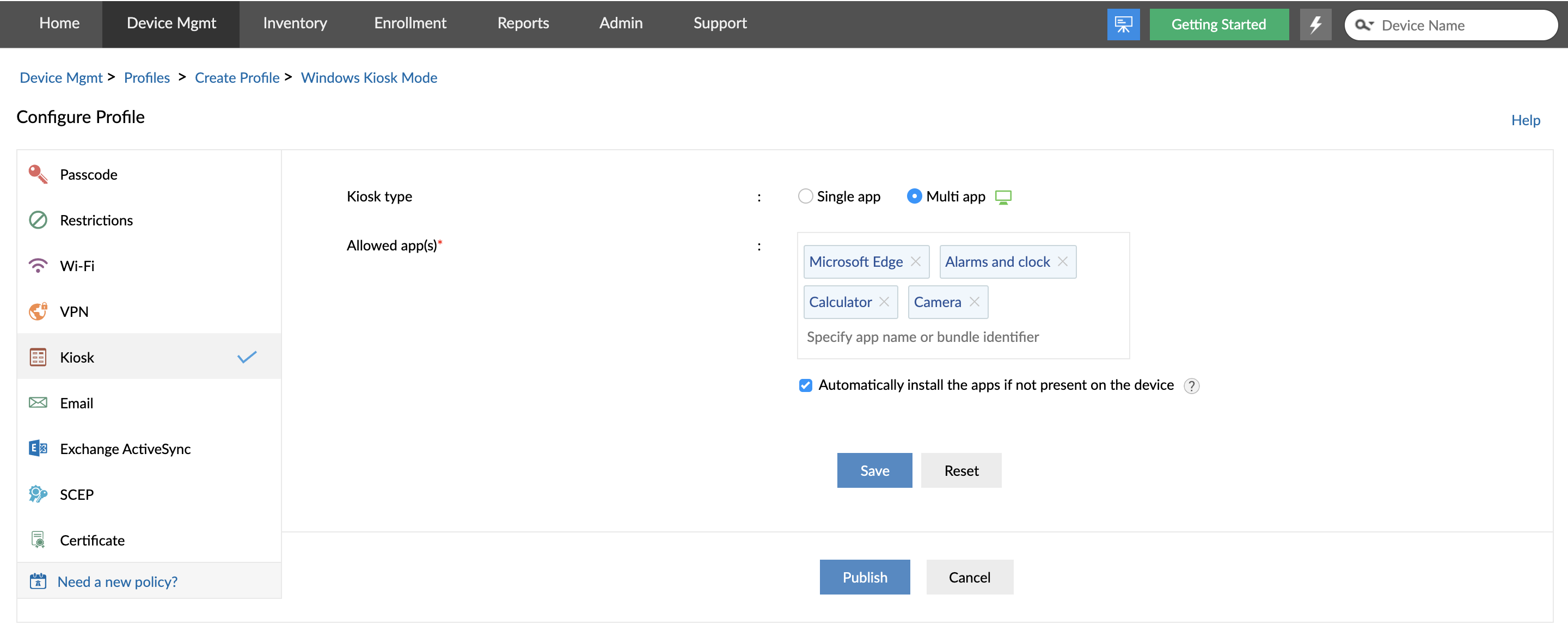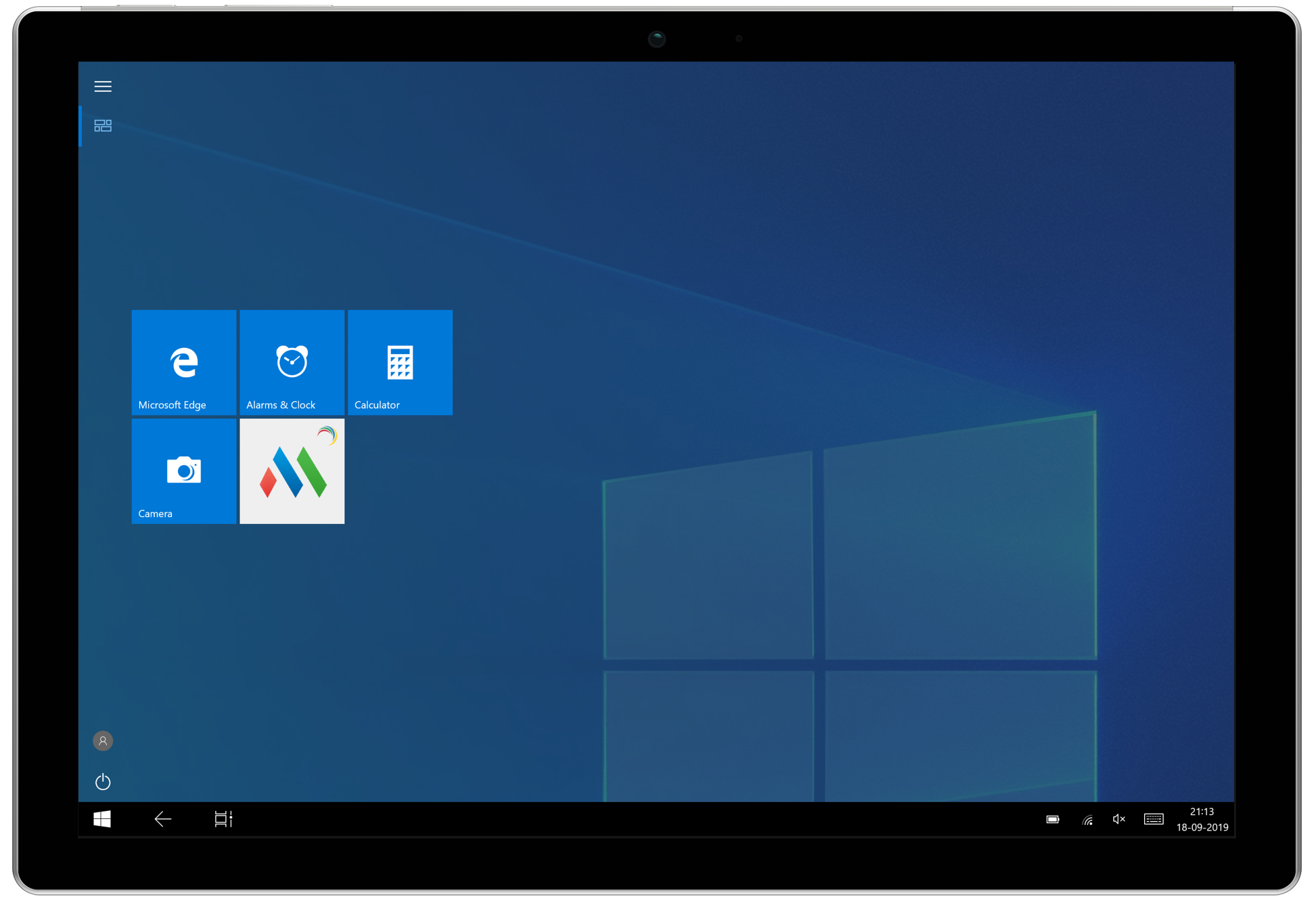How to set up kiosk mode on Windows 10 and Windows 11 devices?
Kiosk Mode is a method using which devices can be restricted to running with specified apps and settings. It serves as a lockdown mechanism in Windows 10 and Windows 11, empowering IT teams and administrators to limit devices to run only one app (or a specific set of apps in the case of Windows 10). This level of control is highly valuable for securing devices used for specific purposes, such as self-check-in kiosks at airports, point-of-sale (POS) terminals in self-service restaurants, and digital advertising signage. Kiosk Mode ensures that users cannot modify device settings, access other features or apps on the devices, or use the device for unintended purposes.
Mobile Device Manager Plus is one such mobile device management (MDM) solution that doubles as a Windows Kiosk software in addition to supporting Kiosk Mode on Apple, Android and Chrome devices. With Mobile Device Manager Plus you can easily enable Kiosk Mode on the Windows devices in your organization.
This Windows 10 and Windows 11 Kiosk Mode guide covers the following:
How to setup Windows 10 or Windows 11 Kiosk Mode using Mobile Device Manager Plus?
To set up Windows 10 & 11 single app kiosk mode or Windows 10 multiple apps kiosk mode, you need to create a Windows Kiosk profile on MDM. Follow the steps given below to configure Kiosk Mode on Windows 10 or Windows 11 devices using Mobile Device Manager Plus as your Windows kiosk software:
Step 1: On the MDM server, click on the Device Mgmt tab.
Step 2: SelectProfiles from the left pane and navigate to Create Profile -> Windows.
Step 3: Provide theName and Description for the profile and click on Continue.
Step 4: Select Kiosk from the left pane to create a Win 10 or 11 Kiosk profile.
Step 5: Now, choose between Single App(Windows 10 & Windows 11) or Multi-App(Windows 10) Kiosk type.
Step 6: In theAllowed Apps tab, specify the app name(s) or bundle identifier(s).

Step 7: Next,Save and Publish the Kiosk profile.
After creating the Windows Kiosk Mode profile, it must be associated with Windows 10 or Windows 11 devices to enable Kiosk Mode. However, it is recommended to test the Kiosk profile on a Windows 10 or Windows 11 test device before associating it with your production environment. When Windows 10 or Windows 11 apps are updated on the MDM server, they are automatically updated on devices provisioned with Windows 10 or Windows 11 Kiosk Mode on the subsequent reboot; no user intervention is required for app updates on devices provisioned in Windows 10 and Windows 11 Kiosk Mode.
What happens on the Windows 10 or Windows 11 device provisioned in Kiosk Mode?
On profile association, when the user provides the login credentials to unlock the device, only the apps provisioned under Windows 10 or Windows 11 Kiosk Mode will be available on the device.

Pre-requisites for Windows 10 and Windows 11 Kiosk Mode
Before a device can be provisioned into a Windows 10 Kiosk Mode or Windows 11 Kiosk Mode, admins must ensure the following pre-requisites are met:
- Device based
- Windows Kiosk Mode is supported for Windows 10 Pro (Version 1709 and later), Enterprise and Education editions, and Windows 11. Kiosk mode is not available for Windows 10 Home edition devices.
- Account based
- Windows 10 and Windows 11 Kiosk Mode are user specific. Hence, enable adding users in Group Policy Editor in the Windows 10 or Windows 11 machine to which you are associating Kiosk policy. To enable adding Users to User groups, open Local Security Policy window. Select User Rights Assignment from the Local Policies dropdown. Click Allow log on locally -> Add User or Group.
- The user must be a standard user. i.e, Kiosk mode is not supported for administrator accounts.
- Application based
- Only Universal Windows Provisioning (UWP) apps, also known as Metro-style apps or Modern apps can be provisioned under Kiosk mode. To know more about UWP apps, click here.
- The apps to be provisioned under Kiosk Mode must be present on the device. In case of managed apps, these are automatically distributed via MDM. For silent installation of apps, they must be present in the App Repository.
How to setup Windows 10 Kiosk Mode or Windows 11 Kiosk Mode manually?
Assigned Access in the in-built feature that allows the Windows 10 & 11 devices to be locked to a single app thereby enabling Single App Kiosk Mode. One major limitation of using the in-built Kiosk Mode on Windows 10 & 11 devices is that you can only provision Microsoft Store apps into Windows Kiosk Mode.
How to enable Windows 10 Kiosk Mode or Windows 11 Kiosk Mode with Assigned Access?
To setup Windows 10 or Windows 11 Kiosk Mode, follow the steps given below:
Step 1: Setup a Standard user account using the Administrator account
Step 2: Open Settings app using Windows Key + I combination.
Step 3: Navigate to Accounts -> Other People -> Set up assigned access
Step 4: Click Choose an Account and select the Standard user account created in Step 1
Step 5: Click Choose an App and select an App from the list of Supported Apps to be added to Windows 10 Kiosk Mode or Windows 11 Kiosk Mode (or Assigned Access)
Step 6: Restart the machine and login using the Standard account credentials to enable Windows 10 Kiosk Mode or Windows 11Kiosk Mode
The device will be locked only to the selected app and the user will not be able to access any other apps or settings on the device, including the Start Menu. Users can sign out of the account using the Ctrl+Alt+Del shortcut.
NOTE: The session will be completely terminated if the system is restarted.
How to disable Windows 10 or Windows 11 Kiosk Mode?
To disable Windows 10 or Windows 11 Kiosk Mode, follow the steps given below:
Step 1: On the Settings app, navigate to Accounts -> Family and other users
Step 2: Under the Setup Kiosk option, select the Assigned Access
Step 3: Under Kiosk Info, select the account and click Remove Kiosk
Drawbacks of Windows 10 Single App Mode or Windows 11 Single App Mode
Though Windows 10 & 11 Single App Mode is an in-built functionality and is available free of cost, it has a few disadvantages over Kiosk Mode on Windows 10 and 11 devices:
- Windows 10 & 11 Single App Mode only allows devices to be locked to a single Microsoft Store app, unlike the Windows Kiosk Mode enabled using a Kiosk Software for Windows devices. A Windows 10 Kiosk software allows devices to be provisioned with multiple apps in the Windows 10 (Win 10 Kiosk Mode).
- The apps should be installed on the device before enabling Kiosk Mode using Assigned Access. Most Windows 10 Kiosk software or Windows 11 software provide options to install apps even after enabling Windows Kiosk Mode
Why do we need a Windows 10 or Windows 11 Kiosk software?
Windows 10 & 11 Kiosk software is required in every organization due to the following reasons:
- With Windows 10 and 11 Single App Mode, admins need to manually provision the apps on the devices and only one app can be added to Kiosk Mode. Whereas, with a Windows Kiosk software like Mobile Device Manager Plus you can provision Windows 10 devices into single app Kiosk mode or multi-app Kiosk mode.
-
Windows 10 Kiosk Mode and Windows 11 Kiosk Mode is supported for laptops, desktops, phones or Surface Pro tablets. A Windows Kiosk software provides a unified console to manage all the Windows 10 and 11 devices and provision these devices into Kisok Mode.
Benefits of Kiosk Software for Windows 10 and Windows 11 devices
Using a Windows Kiosk software to enable Kiosk Mode on Windows 10 and Windows 11 devices has many benefits such as:
- Bulk Kiosk provisioning: With a Kiosk software, admins can remotely provision multiple devices into Win 10 Kiosk Mode or Win 11 Kiosk Mode, unlike Windows 10 or Windows 11 Single App Mode which requires it to be manually enabled on individual devices
- Provision multiple apps in Kiosk Mode:A Kiosk software allows multiple apps to be provisioned into Windows 10 Kiosk Mode, which is not possible using Windows 10 Single App Mode.
- Support for enterprise apps: Using a Kiosk software, admins can also enable using Enterprise apps on Windows 10 Kiosk Mode or Windows 11 Kiosk Mode, where as, Windows 10 & 11 Single App Mode is supported only with Windows Business Store apps.
- Silent installation of apps: While enabling Kiosk Mode admins can select whether the apps should be automatically installed on the devices if they're not already present in the devices provisioned under Windows 10 Kiosk Mode or Windows 11 Kiosk Mode.
Provision devices into Windows 10 Kiosk Mode and Windows 11 Kiosk Mode, with Mobile Device Manager Plus. Give ManageEngine's Windows 10 and Windows 11 Kiosk software a try, free for 30 days!
Frequently asked questions
1. What is Kiosk Mode?
Kiosk Mode is a configuration that allows devices to run a single app or a set of apps while restricting user access to other functionalities or settings. This ensures a secure and focused experience, making it ideal for public-facing devices such as information kiosks, digital signage, and point-of-sale systems.
Learn more about Kiosk Mode.
2. What are the types of Kiosk Mode?
- Single-App Mode: Restricts the device to one specific application.
- Multi-App Mode: Allows access to a limited number of pre-approved apps.
- Browser-Based Kiosk Mode: Locks down devices to run only in a secure web browser.
- Digital Signage Mode: Configures devices to display media content continuously.
Explore ManageEngine's capabilities for Kiosk Management.
3. What are the benefits of Kiosk Mode?
- Enhanced Security: Prevents unauthorized access and tampering.
- Improved Productivity: Focuses users on specific tasks or applications.
- Reduced Maintenance Costs: Simplifies device management.
- User-Friendly Experience: Provides an intuitive interface for users.
View the Kiosk Management Guide.
5. How do I enable Kiosk Mode on different operating systems?
Here's how to enable Kiosk Mode for various OS platforms:
- Windows: Use Assigned Access or Shell Launcher. Learn more.
- macOS: Configure via System Preferences or MDM tools. Learn more.
- iOS/iPadOS: Leverage Guided Access or Single App Mode through MDM. Learn more.
- Android: Use App Pinning or deploy via MDM. Learn more.
- ChromeOS: Configure Kiosk Apps from the Google Admin Console. Learn more.

